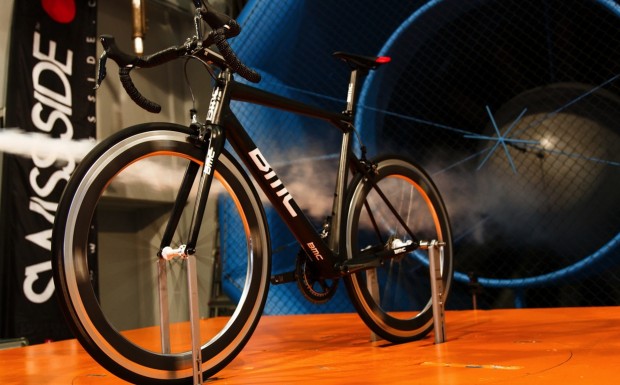Tunnel vision
Despite the increasing use of aerodynamics in bicycle design, wind tunnels appropriate for testing at such comparatively low speeds are few and far between. The observer might wonder why an engineer with a facility sufficiently sophisticated to test Formula One cars at his fingertips would look elsewhere, but the massive expense, and the much higher wind speeds required by Sauber made it an inappropriate tool for testing bicycle wheels, Ballard explains.

Instead, he and his Swiss Side colleagues headed across the Swiss-German border to the GTS wind tunnel, a facility initially created for the testing of aerospace components, but which in recent years has developed a capacity to test bicycles.
Preparation is the watchword when embarking on the expensive and time consuming process of wind tunnel testing, Ballard says. “All of our test plans were written in advance, so we knew exactly which runs we were going to do and in which order, in case we saw certain trends and certain results we were interested in. We knew exactly then how we would modify our test plans to suit.”
Ballard’s team arrived for their eight-hour session armed with their own wheels (the Hadron and others from the range), including 3D printed prototypes of the carbon rim covers to be tested. While Ballard opted against a direct comparison with competitor wheelsets at the CFD stage, preferring instead to focus on optimising the Hadron’s design, back-to-back testing with wheels from leading brands including Mavic (the Cosmic SLS and SLE) and Zipp (the 202 and 808) was a central component of the wind tunnel testing phase.
Also in the arsenal of equipment and materials Ballard and his team had packed for Germany were two MY2014 offerings from another Swiss engineering enterprise: BMC Racing (the Team Machine and Time Machine), shod with brand new tyre sets from Schwalbe (the Ultremo ZX) and Continental (the GP4000s) in a bid to achieve consistency.
“We were testing quite a few tyres because we saw a significant sensitivity in CFD. This was something we were expecting as well from our Formula One experience: we know that tyres can have a massive effect on aerodynamics,” Ballard explains. The team packed plasticine and tape around the tyre-rim interface of the Zipp Firecrest 808, tested in its tubular form, to try and minimise the impact of the differing profile offered by the Hadron clincher.





